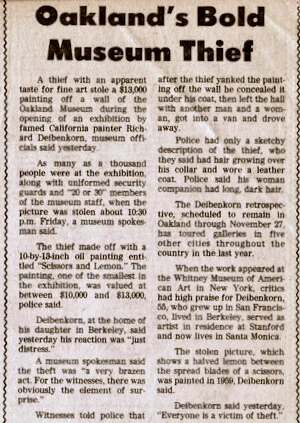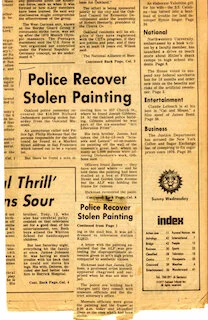In contemporary art, Institutional Critique is the systematic inquiry into the workings of art institutions, such as galleries and museums.
While attending art school at the San Francisco Art Institute, Joe became disillusioned with the rampant commodification and mystification he observed in the art world of 1977.
At a packed opening for Richard Diebenkorn at the Oakland Museum, he made a bold move.
Joe formed the Art Liberation Front to handle the performance of the art theft. In an act he deemed “Marxist”, he removed the frame (held “hostage”) and mailed the painting, along with a manifesto and list of demands, to the local television station KQED. An acquaintance tipped off the police, however, and apprehended Joe shortly after he mailed the painting.
In a live broadcast interview with Connie Chung broadcast from Joe’s SF apartment, he declared, “Basically we’re creating meta-art, which is art about art”.
He elaborated on this in the manifesto attached to his “demand list”: “We are whimsically critical of the art establishment as well as the art-critical contingent, who see art solely in terms of its commodity function.”
Just before Gibbons’ first court appearance, he was interviewed by the legendary SF Examiner reporter Tim Reiterman. Joe elaborated on the ALF’s unique approach to art making: “We are using the media — the news media, precisely — to disseminate our art.”
Reiterman abruptly ended the interview, explicitly rejecting this approach and refused to publish the interview.
Shortly afterwards Reiterman went off to Guyana to cover the People’s Temple in Jonestown and was shot attempting to escape in an airplane along with Congressman Leo Ryan.



